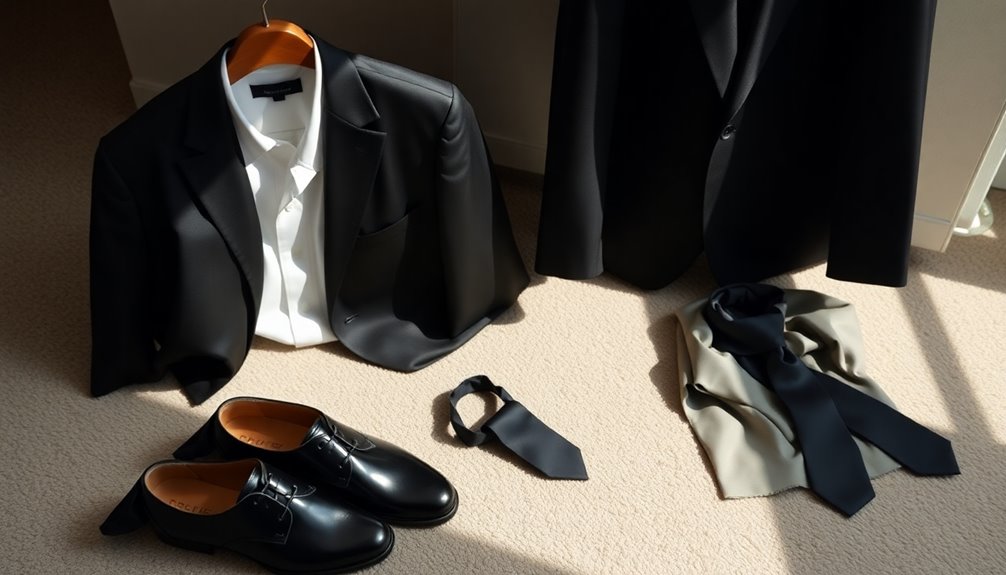When attending a funeral, your attire should reflect respect and solemnity. Opt for dark colors, like black or navy, and choose a conservative outfit—men typically wear a dark suit with a light shirt and tie, while women should consider a modest dress or knee-length skirt paired with a simple blouse. Avoid casual clothing, flashy accessories, and bright colors. Wear closed-toe shoes in a dark hue to maintain an understated look. Comfort is key, as the emotional atmosphere can be overwhelming. Understanding cultural preferences and family wishes can further guide your choices. There's more to explore about this sensitive topic.
Summary
- Choose dark, conservative clothing such as black suits for men and modest dresses or knee-length skirts for women.
- Opt for muted colors like black, gray, or navy, avoiding bright colors and bold patterns to convey respect.
- Wear minimal and understated accessories, such as pearls or small silver pieces, avoiding flashy jewelry that distracts from the occasion.
- Ensure footwear is dark, closed-toe, and polished; avoid casual shoes like sneakers or sandals.
- Familiarize yourself with cultural customs and family wishes regarding attire to ensure appropriate choices for the event.
How to Choose Appropriate Attire for a Funeral
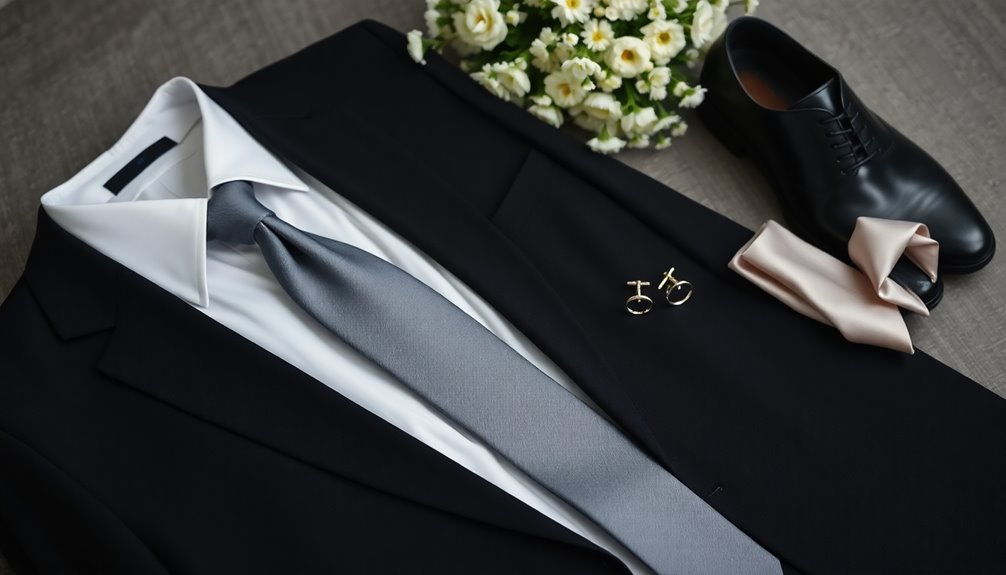
When choosing appropriate attire for a funeral, it's important to prioritize respect and solemnity. Funeral attire plays a vital role in conveying your support and empathy for the bereaved family. Adhering to a respectful funeral dress code not only honors the deceased but also aligns with funeral etiquette.
For men, a dark suit, preferably black, paired with a white or light-colored dress shirt and a conservative tie is ideal. If a full suit isn't available, smart trousers with a blazer can suffice. Men's attire should reflect conservative clothing that shows respect for the occasion. Additionally, it is advisable to err on the side of caution when choosing colors and styles. In some cultures, wearing non-traditional colors may be acceptable and can reflect specific mourning customs. It's also important to note that dark, muted colors are typically favored in many cultures.
Women should opt for modest dresses or skirts that are knee-length or longer, complemented by a simple blouse. Closed-toe shoes in dark colors are a must for both genders.
Avoid casual clothing like jeans or t-shirts, as well as overly flashy outfits. Jewelry should be minimal and understated, allowing the focus to remain on the occasion rather than on individual expression.
Always consider cultural sensitivities that might dictate specific attire choices. By thoughtfully selecting your funeral clothing, you contribute to a respectful atmosphere, ensuring that the day remains focused on honoring the life that's been lost.
Understanding Funeral Etiquette and Expectations
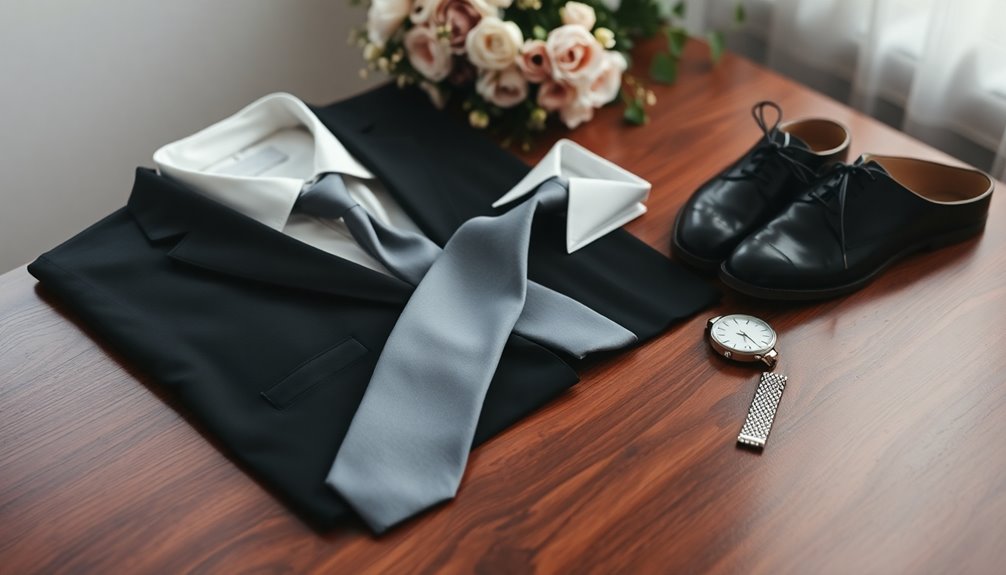
Maneuvering funeral etiquette and expectations is vital for honoring the deceased and supporting their grieving family. Begin by arriving 10-15 minutes early to sign the register book and find your seat. Respect the seating arrangements, as the front rows are typically reserved for immediate family. Additionally, be mindful of what to say to ensure your words provide comfort rather than discomfort.
During the service, silence your phone and keep conversations to a minimum, allowing the solemn atmosphere to prevail. When interacting with the grieving family, focus on expressing your condolences without bringing up grievances. Offer your assistance with household chores or errands, as these gestures can provide much-needed support. It's also important to remember that children at funerals are generally welcome unless specified otherwise by the family. Furthermore, attending at least one event (visitation, wake, service) is crucial for showing support for the grieving family. Wearing respectful attire is essential in conveying your empathy and honoring the memory of the deceased.
Follow the family's lead regarding the tone and mood of the service, and respect their wishes regarding donations or flowers. Your funeral attire guidelines should reflect respectful clothing choices, complemented by appropriate accessories for funerals. Avoid flashy outfits or casual wear, and remember that the essence of your presence is to honor and console.
Adhering to these funeral fashion tips guarantees you contribute to a respectful environment, allowing the family to feel supported during their time of loss. Understanding these etiquette for attending funerals will help you navigate this sensitive occasion with grace.
Traditional Funeral Attire Guidelines for Men and Women
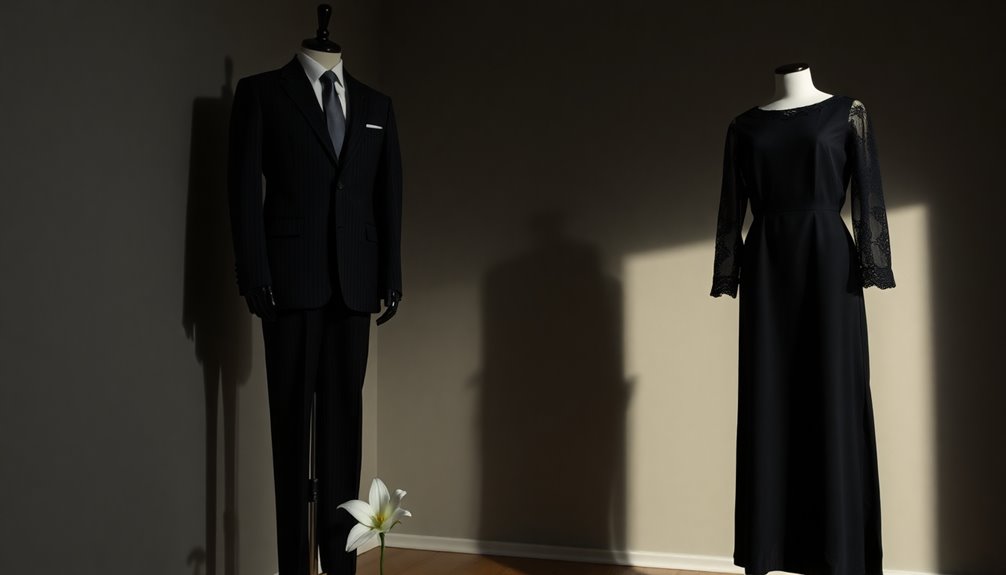
Choosing the right attire for a funeral is essential to honor the deceased and show respect to their loved ones.
When it comes to traditional funeral attire, men should opt for a dark suit, preferably black or navy blue, paired with a long-sleeved white or light-colored dress shirt. A plain black or dark-colored tie and polished black dress shoes complete the look, while minimal accessories like a simple watch maintain the somber tone. Additionally, it is important to ensure that clothing is conservative and comfortable to accommodate the emotional nature of the event.
For women's funeral attire, select simple, dark-colored dresses or skirts that are knee-length or longer. Pair these with a conservative blouse that covers the shoulders. Closed-toe shoes in dark colors are recommended, and jewelry should be understated to avoid drawing attention. It is important to choose conservative silhouettes in solemn fabrics to convey condolences and respect for the occasion.
Both men and women should prioritize comfort, especially during longer services. Conservative funeral attire reflects respect for the occasion, so avoid casual wear, bright colors, or overly flashy outfits.
What Colors to Wear to a Funeral: A Cultural Perspective
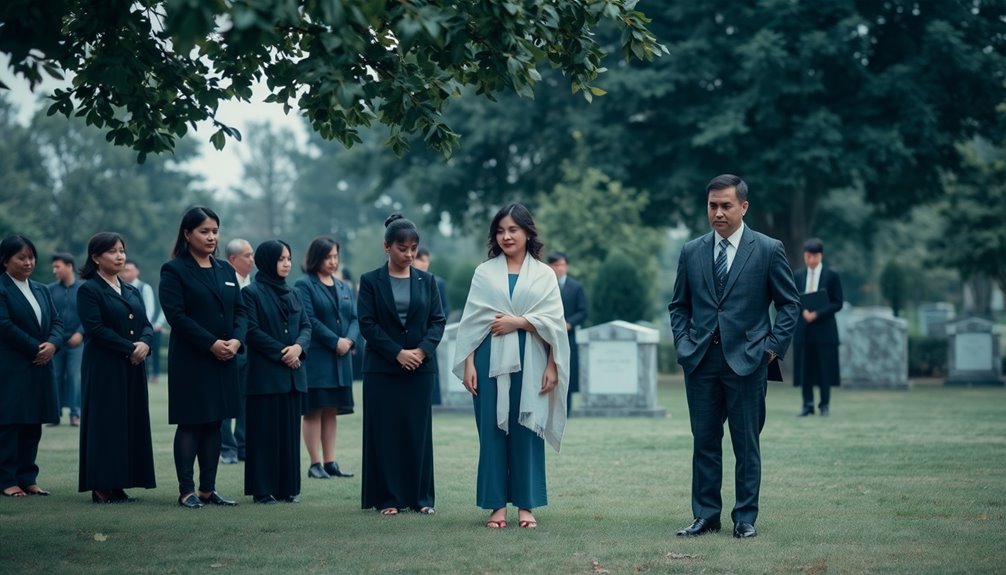
Understanding the significance of color in funeral attire can enhance your expression of sympathy and respect for the deceased. In Western cultures, black remains the traditional mourning color, symbolizing grief and loss. This universal symbolism of color reflects the grief, loss, and healing experienced across various cultures. Interestingly, black has a strong historical connection to mourning traditions, tracing back to Ancient Rome and gaining popularity in the 19th century. Additionally, in Ethiopia, gray is worn during mourning as a way to show respectful mourning. Wearing dark colors other than black can also be a suitable alternative, as they maintain the somber tone of the occasion.
When considering how to dress for a funeral, it's important to acknowledge family wishes for funeral attire, as some may prefer alternative colors.
In contrast, Asian cultures often embrace white as a mourning color, representing purity and rebirth in Buddhist and Hindu traditions. Similarly, in China, white signifies death and is worn to honor the departed.
You might also encounter unique mourning colors in various cultures. For instance, red in South Africa and Ghana symbolizes both mourning and celebration of life, while purple in Catholicism signifies sorrow.
Understanding these cultural nuances helps you navigate colors for funerals with sensitivity. By respecting these traditions, you make sure your attire reflects the solemnity of the occasion, honoring the deceased and their family.
Ultimately, your choice in colors not only conveys your respect but also aligns with the cultural practices that shape our understanding of mourning.
Accessories and Footwear: Completing Your Funeral Ensemble
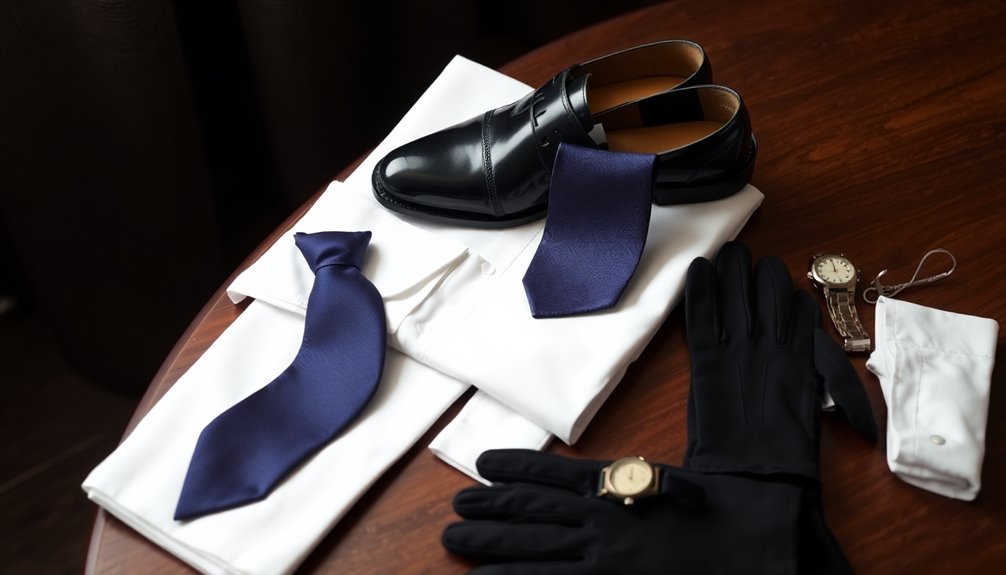
While selecting the right colors can greatly impact your funeral attire, the finishing touches of accessories and footwear complete your ensemble and reflect your respect for the occasion.
When it comes to accessories for funerals, aim for minimal and understated options. Elegant jewelry, like pearls or small sterling silver pieces, conveys a sense of reverence without drawing attention. Classic cufflinks or discreet brooches can add a refined touch, but avoid anything too flashy or bold. Appropriate funeral attire includes accessories that should not distract from the solemnity of the event. Consider choosing subtle jewelry that reflects the deceased's personality or interests, as it can be a meaningful addition. Additionally, remember that cultural customs may influence accessory choices and expectations.
Choosing footwear is equally important. Opt for dark leather shoes, ensuring they're clean and polished. Funeral shoes like dress shoes or loafers in black, navy, or dark gray are ideal.
Steer clear of casual options such as sneakers or sandals, as these don't honor the solemnity of the event.
Remember to take into account the family's wishes or any specific cultural traditions when selecting appropriate accessories. Keeping your choices simple and classic will help maintain the focus on the occasion itself.
What Not to Wear: Avoiding Inappropriate Funeral Attire
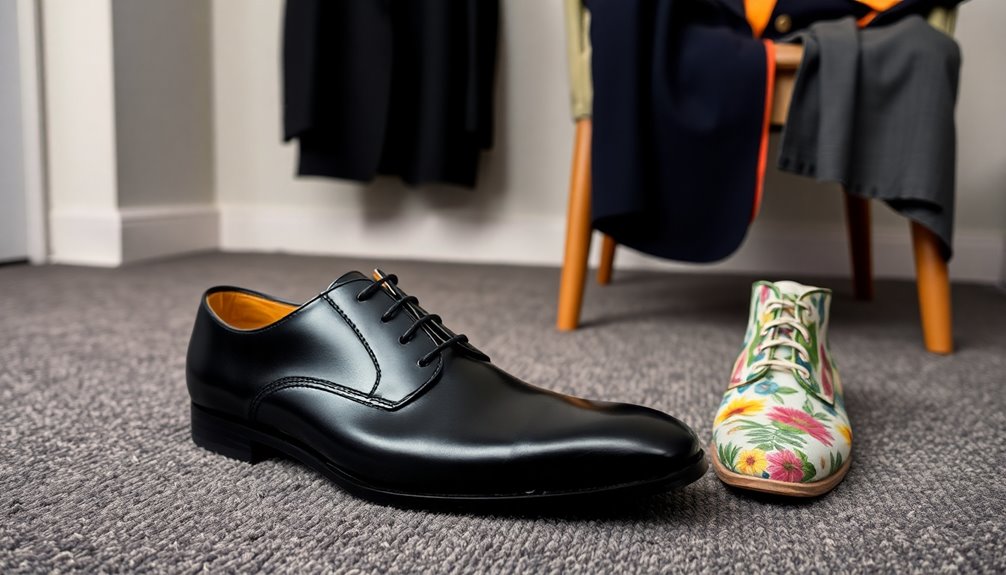
When attending a funeral, there are several key items you should avoid to maintain the solemnity of the occasion. First and foremost, steer clear of casual clothing at funerals—jeans, t-shirts, and sneakers are inappropriate funeral attire that detracts from the gravity of the event. Bright colors and bold patterns should also be left at home; they can be seen as disrespectful. Instead, opt for dark, muted tones that convey your condolences. It is also important to remember that cultural norms regarding funeral attire may influence what is considered appropriate.
Specific items to avoid include anything overly ornate or revealing, such as low-cut tops or short skirts. Confirm your clothing is clean and free of stains or tears, as damaged attire can appear careless. Accessories should be minimal; flashy jewelry only serves to draw attention away from the purpose of the gathering. Traditional attire is typically conservative and subdued, so choosing appropriate clothing is essential. Additionally, consider wearing smart yet comfortable shoes to ensure you can navigate the venue with ease. It's also important to remember that cultural traditions regarding funeral attire can vary significantly, so be mindful of any specific customs or requests from the family regarding dress.
Ultimately, understanding what not to wear to a funeral helps you honor the deceased and support their family during a profoundly emotional time. By adhering to these guidelines, you can contribute to a respectful atmosphere befitting the occasion.
Considerations for Children's Attire at Funerals
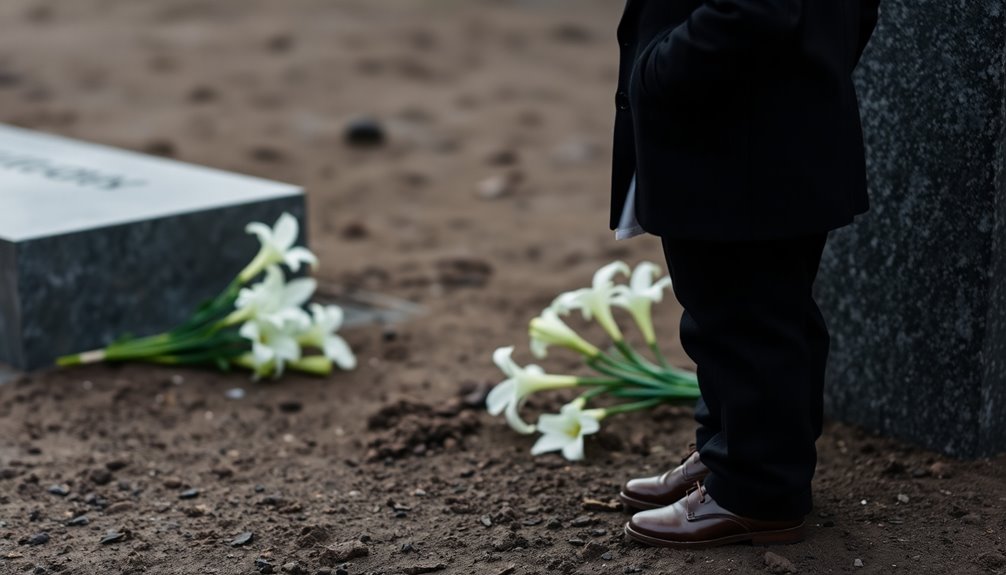
At a funeral, selecting appropriate attire for children is essential to guarantee they convey respect for the occasion. While children aren't required to wear black, opting for muted colors for funerals, such as navy, maroon, or gray, is advisable. Aim for neutral, modest clothing similar to their school attire, ensuring they remain comfortable throughout the service. Some parents believe kids may be traumatized by funerals, so it's crucial to help them understand the significance of the event. Additionally, emphasizing simplicity in attire can help children feel more relaxed and focused during the service.
When dressing children for funerals, focus on a funeral outfit checklist that includes simple button-up shirts for boys and dresses or blouses for girls. For boys, appropriate funeral attire might consist of slacks in dark hues paired with a button-up shirt and dress shoes—sneakers and sandals should be avoided. It's important to ensure that outfits are made from comfortable fabrics to help them feel at ease during the service.
Girls can wear understated dresses or skirts with blouses, layering with cardigans if needed. Comfort is key; children should be able to sit and stand easily. Avoid bright colors, busy prints, and flashy accessories. Closed-toe shoes with minimal visibility of toes are best.
Respecting Family Wishes: Dressing for Different Types of Funerals
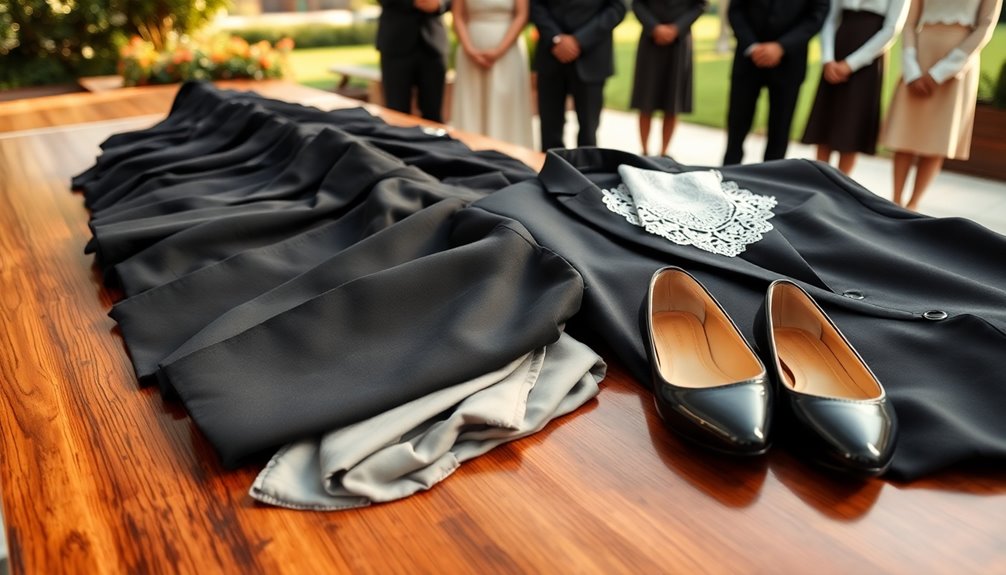
Respecting family wishes during a funeral is essential to guarantee that attendees honor the deceased and support their loved ones. When attending a traditional service, opt for a black suit for funerals or a dark dress, ensuring your funeral service attire aligns with the family's expectations.
For cultural or religious funeral attire, familiarize yourself with specific customs that may dictate your outfit choice, as some traditions require modesty or specific colors. It is also important to dress conservatively to show respect for the deceased.
In warmer months, consider funeral attire for summer by selecting breathable fabrics while maintaining a somber tone. If the family prefers a celebration of life theme, brighter colors might be appropriate, but always confirm their wishes first.
Avoid casual clothing, flashy accessories, or anything that could detract from the solemnity of the occasion.
Ultimately, your attire should reflect respect for the deceased and support for their family. By adhering to these guidelines and being mindful of family wishes, you can contribute to a dignified atmosphere that honors the memory of the departed.
FAQ
Can I Wear Jeans to a Funeral?
You shouldn't wear jeans to a funeral. Instead, opt for respectful attire like dark trousers or a simple dress. Your clothing should honor the occasion and reflect your support for the grieving family.
Is It Acceptable to Wear a Hat?
Wearing a hat can be acceptable, depending on cultural customs and the family's wishes. If unsure, consider removing it during the service to guarantee respect and attentiveness to the occasion. Always prioritize modesty and simplicity.
Should I Avoid Bright Colors Entirely?
You should generally avoid bright colors at a funeral, as they can distract from the solemnity of the occasion. Instead, opt for darker, more subdued tones to show respect for the deceased and their family.
What if I Don't Own Formal Attire?
If you don't own formal attire, opt for dark dress pants and a simple blouse or button-down shirt. Make certain your clothes are clean and well-fitted, and keep accessories minimal to maintain a respectful appearance.
Can I Wear Casual Shoes Like Loafers?
You can wear loafers if they're dark, polished, and appropriate for the occasion. However, guarantee they maintain a respectful tone, avoiding casual styles that might distract from the solemnity of the event.
Final Thoughts
In choosing your funeral attire, remember that your clothing reflects respect for the deceased and their family. Opt for darker colors, traditional styles, and avoid anything too casual or flashy. By being mindful of these guidelines, you not only honor the memory of the departed but also provide comfort to those grieving. Ultimately, dressing appropriately is a simple yet profound way to express your support during such a solemn occasion.
